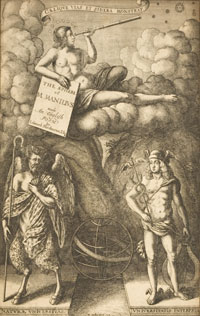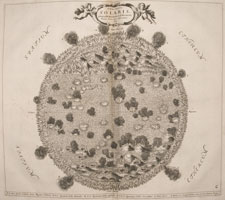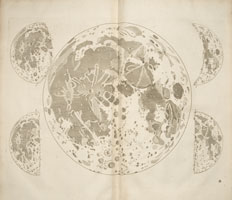The sphere of Marcus Manilius made an English poem with annotations and an astronomical appendix by Sir Edward Sherburne (London : Printed for Nathanael Brooke, 1675)
Click on the images to enlarge
This folio volume contains the first book of Marcus Manilius' Astronomicon, which is thought to be the oldest treatise on astrology, and a lengthy appendix by Sherburne. Little is known about Manilius except that he was a resident of Rome in the first century AD.1 The full version of the Astronomicon contains five books, the first on astronomy, and the remainder on astrology. The first book includes information on the constellations, planets, celestial circles and comets. Sherburne's appendix features a history of astronomy and 'A Catalogue of the Most Eminent Astronomers, Ancient and Modern'.
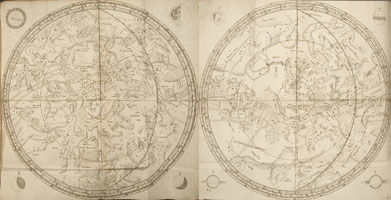 The sphere of Marcus Manilius contains a number of engraved illustrations, the most impressive being the frontispiece. This shows Pan on the left and Mercury (or Hermes) on the right with Urania, the muse of astronomy, floating above gazing at the heavens through a telescope. Pan is shown, somewhat unusually with wings, representing nature. Mercury (usually depicted with wings owing to his role as messenger) stands on a plinth inscribed 'university of interpretation' providing a connection between nature (Pan) and the celestial (Urania).2 Goold states, in his introduction to the Astronomicon:
The sphere of Marcus Manilius contains a number of engraved illustrations, the most impressive being the frontispiece. This shows Pan on the left and Mercury (or Hermes) on the right with Urania, the muse of astronomy, floating above gazing at the heavens through a telescope. Pan is shown, somewhat unusually with wings, representing nature. Mercury (usually depicted with wings owing to his role as messenger) stands on a plinth inscribed 'university of interpretation' providing a connection between nature (Pan) and the celestial (Urania).2 Goold states, in his introduction to the Astronomicon:
'... the god Mercury simulated interest in the sky and paved the way for the ultimate discovery that destiny is written in the stars'.3
As well as being visually attractive this book also embodies a very specific agenda significant in the history of science in late 17th-century England: to promote modern astronomy and encourage its readership to provide financial patronage. An example of this is the paragraph at the end of the Catalogue supporting the new observatory at the University of St Andrews.4 Sherburne seeks to achieve this, in part, by depicting modern astronomers as the most recent participants in an august tradition traceable back to classical antiquity and biblical times. He hoped to inspire his readers to learn about and support astronomy by providing them with an entertaining and informative book using the method of 'Knowledge with delight'.5
Acquired in 2005 at the sale of the Earl of Macclesfield's library at Shirburn Castle (one of Britain's finest private collections of early science books), this volume has been an important addition to the Whipple Library and an interesting resource for students to study.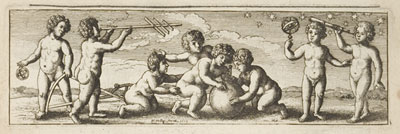
Mind of the Frontispiece
'The Spheres, (which ever moving are) imply
That Arts and Learning, if unactive, die.
Our subject's Worth is by URANIA meant,
Our Poet's, PAN and MERCURY present,
Who sings rough Matter in smooth Verse, t'invite
The Ignorant to Learn, the Learn'd Delight'
References and Bibliography
1 Gillispie, C.C., Dictionary of scientific biography vol. 9 (New York: Scribner, 1974).
2 For more details of the frontispiece see Horry, R., The mind of the frontispiece: myth, meaning and motivation in Sherburne's 'Manilius' (unpublished dissertation, 2003).
3 Manilius, Astronomica with an English translation by G.P. Goold (Cambridge, MA.: Harvard University Press, 1977), xvii.
4 Horry, R., The mind of the frontispiece: myth, meaning and motivation in Sherburne's 'Manilius' (unpublished dissertation, 2003).
5 Sherburne (1675), first page of preface (un-numbered).
- Birrell T.A., 'The Library of Sir Edward Sherburne (1616–1702)' in A. Hunt, G. Mandelbrote and A. Schell, eds, The Book Trade and its Customers 1450–1900 (Winchester and Newcastle, DE: St Paul's Bibliographies and Oak Knoll Press, 1997), 189–204.
- Gaskell, R. and Fara, P., 'Selling the silver: country house libraries and the history of science', Endeavour 29 (1) (2005), 14–19.
- Poole, William, 'Loans from the Library of Sir Edward Sherburne and the 1685 English Translation of Xenophon', The Library 7th Series, 14 (2013), 80–87.
- Volk, K., The poetics of Latin didactic (Oxford: Oxford University Press, 2002).
- Volk, K., Manilius and his intellectual background (OUP, 2009).

